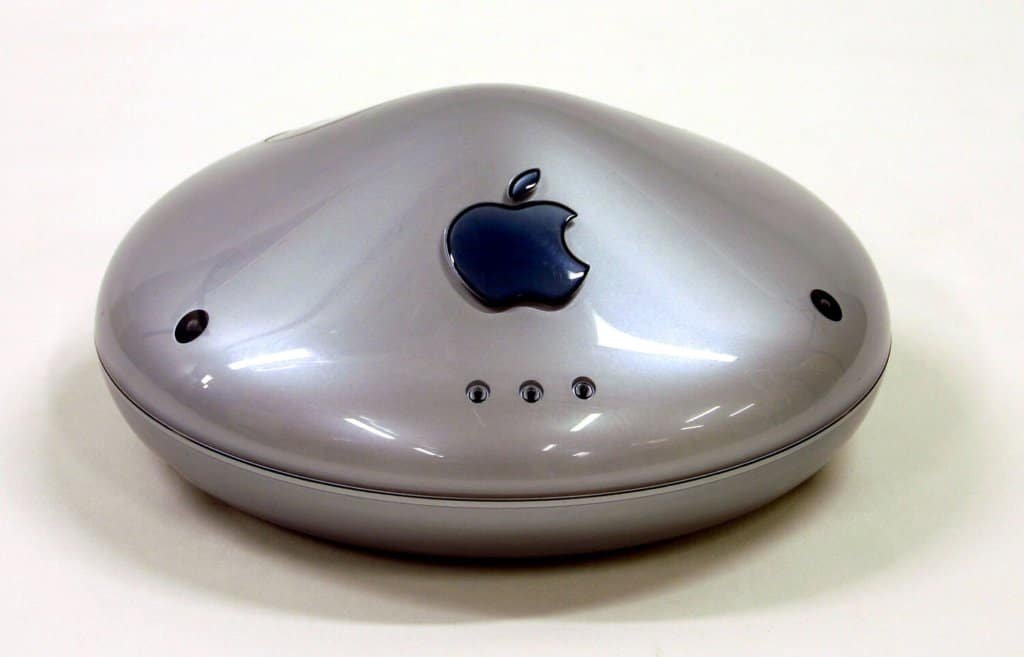In the fast-paced world of technology, it’s easy to forget the milestones that paved the way for our seamless digital experiences today. One such trailblazer is the Apple AirPort Base Station, introduced in 1999 and marking the onset of the wireless revolution.
In the late ’90s, Apple was on the cusp of innovation, and in 1999, they revealed the AirPort Base Station, a wireless router that defied the norms of its time. Steve Jobs, in his iconic “one more thing” moment at Macworld New York, showcased the device, featuring wireless internet technology on an iBook – a spectacle that left the audience in awe.
The AirPort Base Station, part of the broader AirPort Base Station series, was more than just a router. It embodied futuristic features such as a WLAN port for DSL routing, cross-platform compatibility with Windows PCs, 128-bit encryption ensuring robust security, and the ability to connect up to 10 devices simultaneously.
The original AirPort Base Station, dubbed “Graphite,” was a marvel of its time. Released on July 21, 1999, this device featured a dial-up modem, an Ethernet port, and utilized a Lucent WaveLAN Silver PC Card as the radio, all powered by an embedded AMD Élan SC410 processor. Its primary function was to facilitate the connection of wireless-enabled computers to the Internet, creating a network where devices could seamlessly communicate.
Despite its cutting-edge technology, the Graphite AirPort Base Station had firmware-locked limitations, allowing only 40-bit WEP encryption. However, ingenious aftermarket tweaks enabled users to unlock 128-bit WEP encryption, extending the unit’s service life.
The AirPort Base Station marked the beginning of the wireless revolution, eliminating the need for cumbersome wires to connect computers and peripherals. It was more than just a router; it was the harbinger of Wi-Fi – the industry-standard wireless connectivity solution we now take for granted.
The device facilitated the connection of wireless-enabled computers to the Internet, creating a bridge between devices, wired LANs, and other peripherals like printers and music amplifiers. Its innovative ‘flying saucer’ design housed a network router with a dial-up modem and a port for broadband modem connection, offering a throughput of 11 Mbps to up to 10 users within a range of 50 meters.
Despite its discontinuation in November 2001, the Graphite AirPort Base Station left an indelible mark on the history of Apple. Launched with a starting price of $299, it was eventually succeeded by the AirPort Base Station with Dual Ethernet in 2001, marking progress in Apple’s relentless pursuit of innovation.
Today, 24 years after its introduction, the AirPort Base Station stands as a timeless piece of hardware, a testament to Apple’s early forays into wireless technology. Its legacy lives on not only in the hearts of seasoned tech enthusiasts but also as a significant chapter in the evolution of Apple’s product lineup.
As we reflect on the AirPort Base Station’s journey, its enduring appeal becomes apparent. Whether you’re delving into the annals of tech history or simply intrigued by Apple’s past, this device holds a unique place. Its seamless integration with the first iBook, its compatibility with various internet protocols making it an economical networking solution for PCs, and its role in heralding a wireless era – these facets contribute to its timeless allure.
The AirPort Base Station remains a symbol of Apple’s commitment to innovation and a key player in the early chapters of wireless connectivity. Its story is not just about technology; it’s a narrative of progress, adaptability, and the relentless pursuit of a wire-free future. So, as we celebrate the marvels of the present, let’s not forget to pay homage to the devices that laid the foundation for our connected world. The AirPort Base Station, with its ‘Graphite’ origins, continues to shine bright in the constellation of technological advancements.

AirPort Base Station Details
| Introduced | July 21, 1999 |
| Discontinued | November 13, 2001 |
| Model Number | M5757 |
| Order Number | M7601LL/A M7601LL/B |
| Original Price | $299 |
| Weight | 1.65 Ibs. 748.42 Grams |
| Dimensions | 6.9″ D x 3.2″ H 17.52 cm D x 8.12 cm H |
Wireless Specs
| Wireless Data Range | Up to 11 Mbps |
| Range | 150 ft. 50 m |
| Compatibility | Wi-Fi (802.11b) |
| Frequency | 2.4 GHz |
| Radio Output Power | 15 dBm (nominal) |
| Security | WEP (40-bit encryption) |
| Capacity | 10 users |
| Supported Protocols | AppleTalk TCP/IP NAT DHCP UDP FTP PPPoE L2TP DNS IPSec/VPN Passthrough SNMP Telnet |
Connections
| Ports | 1 – RJ-45 1 – RJ-11 for built-in 56k modem |
| Storage | None |
| AirPlay | No |
| Power over Ethernet | No |
Further Reading and References
- AirPort Base Station (Graphite): Technical Specifications – Apple Support
- AirPort – Wikipedia
- Wireless Modem – Apple Airport Base Station – ‘Graphite’ – Museums Victoria Collections
- Apple Airport Wireless Base Stations – Northern Arizona University
- Requiem for the AirPort base station: A testament to everything Apple was and isn’t anymore – MacWorld
Disclaimer: The data presented in this article is under continuous development and has been manually collected from various sources based on their availability. The author of this article may revise this dataset as additional research is conducted and reviewed. Please note that the information is provided “as is” and “as available” without express or implied warranties. The author cannot be held responsible for any omissions, inaccuracies, or errors in the published information. Any warranties relating to this information are hereby disclaimed.
Last updated: January 14, 2024
